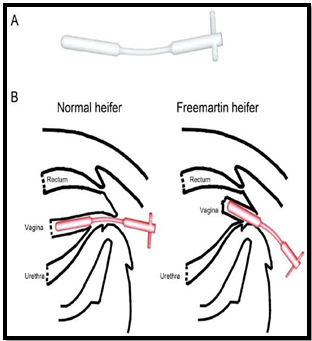FREEMARTINS: NATURE’S ANOMALIES IN CATTLE
Nature’s diversity extends to the animal kingdom, presenting anomalies even in the classification of sexes. Freemartins, a phenomenon observed in cattle, embody this uniqueness.
Source: Research Gate
Freemartin
- Freemartins are female cattle that are born sterile and have some male characteristics.
- They are the result of an abnormal development of the reproductive system, which occurs when a female calf shares the same placenta with a male calf.
- This sharing of blood causes the female calf to receive some male hormones, which masculinize her reproductive organs.
Freemartin Characteristics
- Freemartins are sterile female cattle that arise from twin pregnancies where one is male and the other female.
- This occurrence is prevalent, accounting for about 90% of twin pregnancies in cattle.
- The key factor behind freemartinism is the exchange of blood between the male and female foetuses during gestation.
Genetic Basis
- Freemartinism is genetically linked to the sharing of cells carrying the Y chromosome from the male twin to the female twin.
- The Y chromosome influences the development of male reproductive organs in the male foetus.
- In contrast, the female foetus, influenced by male hormones, undergoes incomplete development of its reproductive system.
Reproductive Implications
- Freemartins possess underdeveloped or non-functional reproductive tracts.
- Due to their sterility, farmers commonly cull freemartins from the breeding herd in agricultural settings.
Agricultural Considerations
- Farmers identify freemartins through physical and behavioural traits.
- The culling of freemartins is a strategic approach to enhance reproductive efficiency in the breeding herd.
Freemartins stand as nature’s peculiar creation among cattle, showcasing how biological variations can occur, even within the intricate dynamics of twin pregnancies. In agricultural practices, understanding and managing these anomalies contribute to maintaining a robust and productive breeding





